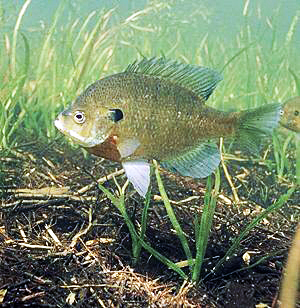By Industry Expert David Beasley, Fisheries Biologist
 Many times when people think about fish populations within ponds they don’t understand the entire food chain. Often it is thought that Bluegill and Bass are all you need to have a healthy fishery. Although it is true that Bluegill play a big role in the success and health of most freshwater ponds, the reality is that the food chain has much more detail.
Many times when people think about fish populations within ponds they don’t understand the entire food chain. Often it is thought that Bluegill and Bass are all you need to have a healthy fishery. Although it is true that Bluegill play a big role in the success and health of most freshwater ponds, the reality is that the food chain has much more detail.
Plankton is the base of the food chain in ponds and lakes. Plankton is broken down into two categories, phytoplankton which are microscopic plants (green) and zooplankton which are microscopic animals (brown). Phytoplankton rely on four things to grow: sunlight, available nutrients, CO2 and water temperature above the mid 50’s. The primary predator to phytoplankton is zooplankton. Large phytoplankton populations will give the water a green color, whereas large zooplankton populations will give the water a brown color. Often times in ponds phytoplankton and zooplankton populations will fluctuate back and forth as populations increase and decrease, resulting in the water color changing between bright green, olive green, olive brown and brown. In ponds with an aeration system the plankton populations will be more stable due to good nutrient management and the additional oxygen source. In ponds where an abundant population of fish is desired, increasing plankton populations should be considered. Next up the food chain are invertebrates. Invertebrates feed on plankton, plants, small fish and detritus (decaying organics). Invertebrates play an important role as food for larger invertebrates and fish, while they also further the decomposition of organics. A healthy, high quality invertebrate population hinges greatly on good healthy water. With a good population of invertebrates, small fish will prosper. Small fish are very important to the food chain, as large fish depend on them for survival. Small fish feed heavily on both phytoplankton and zooplankton, while also consuming available invertebrates and other small fish when possible. It is important that small fish have abundant food available to give them the needed energy to face life’s challenges. Survival for small fish is difficult, so having abundant food is needed. Larger fish begin playing a role at this point, primarily feeding on invertebrates and smaller fish. Fish diets vary between the species, but most fish tend to feed on what is readily available. A few species that have a unique diet are Grass Carp and Shellcracker. Grass Carp feed primarily on submerged aquatic vegetation, while Shellcracker play a more unique role, targeting mollusks as their primary food source. Shellcraker’s unique diet will help break the life cycle of parasites within the pond that are hindering the health of the fish. The life cycle of many aquatic parasites have three stages within three hosts. Their first hosts are mollusks, then fish, and then finally birds. To break this parasitic life cycle, Shellcrackers consume the mollusks, leaving a void in the parasites host requirement, keeping the parasite from being able to infect fish. Predator fish are much more vulnerable to going hungry than those lower in the food chain since they are relying both on the smaller fish’s success and competing with their own tendencies to over populate. Having a balance of predator to prey species will be a continuing part of any successful fisheries management program. Too many top end predators will put a large strain on the smaller fish, bringing instability to the food chain. It is very important to actively remove top end predators from ponds before their populations overpopulate. Overall the food chain is relatively straight forward. The Food Chain ties directly into the much larger picture of the “Food Web.” The Food Web takes into consideration the “Food Chain” along with all of the Aquatic and Environmental variables that influence the aquatic life such as vegetation, water quality, runoff, sunlight, etc. To maintain a prosperous aquatic environment, the food chain needs to be in check, and the Food Web needs to be understood. Many ponds often require assistance from aeration, fertilization, vegetation treatment, Grass Carp, additional forage fish, harvesting bass, along with many other management practices. There are dozens of variables that can be modified to bring stability to the ecosystem and each lake or pond is a little different than the next. The more that is known about your pond or lake, the more it can be positively influenced by using good management practices.
Contact the experts at 888-480-5253 for all of your lake, pond and fisheries management needs.
David Beasley is a Fisheries Biologist with SOLitude Lake Management. Since 1998, SOLitude Lake Management has been committed to providing full service lake and pond management services that improve water quality, preserve natural resources, and reduce our environmental footprint. Services are available throughout the Eastern United States. Fisheries management consulting and aquatic products are available nationwide. Learn more about SOLitude Lake Management and purchase products at www.solitudelakemanagement.com.










